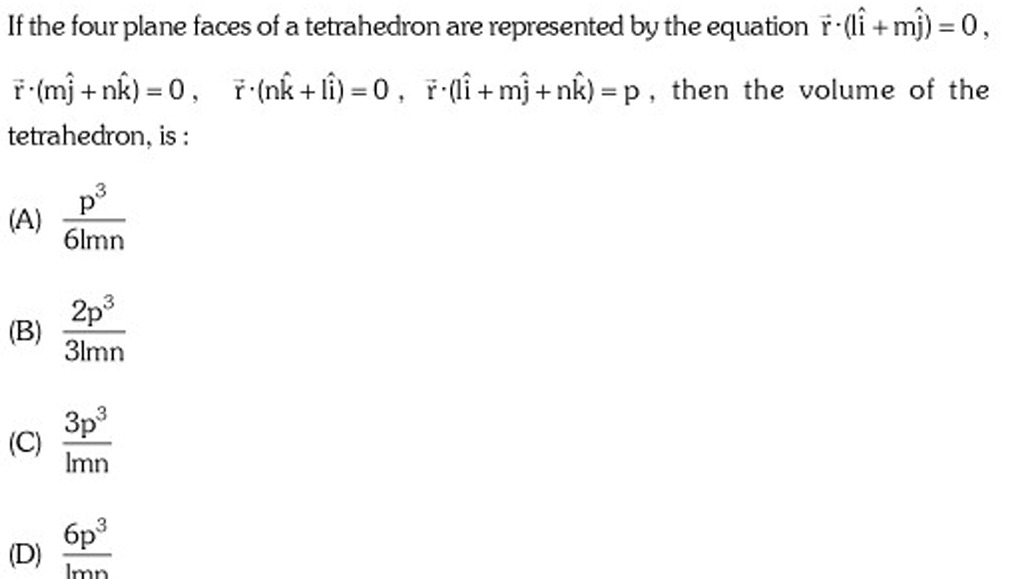Question
Question: If the four plane faces of a tetrahedron are represented by the equation $\overrightarrow{r} \cdot (...
If the four plane faces of a tetrahedron are represented by the equation r⋅(li^+mj^)=0, r⋅(mj^+nk^)=0, r⋅(nk^+li^)=0, r⋅(li^+mj^+nk^)=p, then the volume of the tetrahedron, is :

6lmnp3
3lmn2p3
lmn3p3
lmn6p3
3lmn2p3
Solution
The four given planes are:
Plane 1: lx+my=0
Plane 2: my+nz=0
Plane 3: lx+nz=0
Plane 4: lx+my+nz=p
Step 1: Find the Vertices
-
Vertex A: Intersection of planes 1, 2, and 3. Solving the system of equations lx+my=0, my+nz=0, and lx+nz=0 yields x=y=z=0. Thus, A=(0,0,0).
-
Vertex B: Intersection of planes 1, 2, and 4. Solving the system lx+my=0, my+nz=0, and lx+my+nz=p gives B=(lp,−mp,np).
-
Vertex C: Intersection of planes 1, 3, and 4. Solving the system lx+my=0, lx+nz=0, and lx+my+nz=p gives C=(−lp,mp,np).
-
Vertex D: Intersection of planes 2, 3, and 4. Solving the system my+nz=0, lx+nz=0, and lx+my+nz=p gives D=(lp,mp,−np).
Step 2: Compute the Volume
The volume V of a tetrahedron with vertices A, B, C, and D (with A at the origin) is:
V=61det(B,C,D)
Where:
B=(lp,−mp,np)
C=(−lp,mp,np)
D=(lp,mp,−np)
Factoring out p from each vector:
det(B,C,D)=p3detl1−l1l1−m1m1m1n1n1−n1
Let M denote the matrix:
M=l1−l1l1−m1m1m1n1n1−n1
Calculate det(M) by expansion:
det(M)=l1det(m1m1n1−n1)−(−m1)det(−l1l1n1−n1)+n1det(−l1l1m1m1)
Evaluate the 2x2 determinants:
-
det(m1m1n1−n1)=m1(−n1)−n1(m1)=−mn2.
-
det(−l1l1n1−n1)=(−l1)(−n1)−(n1)(l1)=ln1−ln1=0.
-
det(−l1l1m1m1)=(−l1)(m1)−(l1)(m1)=−lm2.
Substitute back:
det(M)=l1(−mn2)+m1⋅0+n1(−lm2)=−lmn2−lmn2=−lmn4.
Taking the absolute value gives:
∣det(M)∣=lmn4.
Thus, the volume is:
V=61p3⋅lmn4=6lmn4p3=3lmn2p3.
